Potrebujeme váš súhlas na využitie jednotlivých dát, aby sa vám okrem iného mohli ukazovať informácie týkajúce sa vašich záujmov. Súhlas udelíte kliknutím na tlačidlo „OK“.
ASTM C1239-13
Standard Practice for Reporting Uniaxial Strength Data and Estimating Weibull Distribution Parameters for Advanced Ceramics
Automaticky preložený názov:
Štandardná prax pre Reporting jednoosý Strength dát a odhad Weibullových rozdelenie parametrov pre pokročilú Keramika
NORMA vydaná dňa 1.8.2013
Informácie o norme:
Označenie normy: ASTM C1239-13
Poznámka: NEPLATNÁ
Dátum vydania normy: 1.8.2013
Kód tovaru: NS-10195
Počet strán: 18
Približná hmotnosť: 54 g (0.12 libier)
Krajina: Americká technická norma
Kategória: Technické normy ASTM
Kategórie - podobné normy:
Anotácia textu normy ASTM C1239-13 :
Keywords:
advanced ceramics, censored data, confidence bounds, fractography, fracture origin, maximum likelihood, strength, unbiasing factors, Weibull characteristic strength, Weibull modulus, Weibull scale parameter, Weibull statistics, ICS Number Code 81.060.99 (Other standards related to ceramics)
Doplňujúce informácie
| Significance and Use | ||||||||||||||||||||||||||||||||||||||||||||
|
5.1 Advanced ceramics usually display a linear stress-strain behavior to failure. Lack of ductility combined with flaws that have various sizes and orientations leads to scatter in failure strength. Strength is not a deterministic property but instead reflects an intrinsic fracture toughness and a distribution (size and orientation) of flaws present in the material. This practice is applicable to brittle monolithic ceramics that fail as a result of catastrophic propagation of flaws present in the material. This practice is also applicable to composite ceramics that do not exhibit any appreciable bilinear or nonlinear deformation behavior. In addition, the composite must contain a sufficient quantity of uniformly distributed reinforcements such that the material is effectively homogeneous. Whisker-toughened ceramic composites may be representative of this type of material. 5.2 Two- and three-parameter formulations exist for the Weibull distribution. This practice is restricted to the two-parameter formulation. An objective of this practice is to obtain point estimates of the unknown parameters by using well-defined functions that incorporate the failure data. These functions are referred to as estimators. It is desirable that an estimator be consistent and efficient. In addition, the estimator should produce unique, unbiased estimates of the distribution parameters 5.3 Tensile and flexural test specimens are the most commonly used test configurations for advanced ceramics. The observed strength values are dependent on test specimen size and geometry. Parameter estimates can be computed for a given test specimen geometry ( m^, σ^5.4 Many factors affect the estimates of the distribution parameters. The total number of test specimens plays a significant role. Initially, the uncertainty associated with parameter estimates decreases significantly as the number of test specimens increases. However, a point of diminishing returns is reached when the cost of performing additional strength tests may not be justified. This suggests that a practical number of strength tests should be performed to obtain a desired level of confidence associated with a parameter estimate. The number of test specimens needed depends on the precision required in the resulting parameter estimate. Details relating to the computation of confidence bounds (directly related to the precision of the estimate) are presented in 9.3 and 9.4. |
||||||||||||||||||||||||||||||||||||||||||||
| 1. Scope | ||||||||||||||||||||||||||||||||||||||||||||
|
1.1 This practice covers the evaluation and reporting of uniaxial strength data and the estimation of Weibull probability distribution parameters for advanced ceramics that fail in a brittle fashion (see Fig. 1). The estimated Weibull distribution parameters are used for statistical comparison of the relative quality of two or more test data sets and for the prediction of the probability of failure (or, alternatively, the fracture strength) for a structure of interest. In addition, this practice encourages the integration of mechanical property data and fractographic analysis. 1.2 The failure strength of advanced ceramics is treated as a continuous random variable determined by the flaw population. Typically, a number of test specimens with well-defined geometry are failed under isothermal, well-defined displacement and/or force-application conditions. The force at which each test specimen fails is recorded. The resulting failure stress data are used to obtain Weibull parameter estimates associated with the underlying flaw population distribution. 1.3 This practice is restricted to the assumption that the distribution underlying the failure strengths is the two-parameter Weibull distribution with size scaling. Furthermore, this practice is restricted to test specimens (tensile, flexural, pressurized ring, etc.) that are primarily subjected to uniaxial stress states. The practice also assumes that the flaw population is stable with time and that no slow crack growth is occurring. 1.4 The practice outlines methods to correct for bias errors in the estimated Weibull parameters and to calculate confidence bounds on those estimates from data sets where all failures originate from a single flaw population (that is, a single failure mode). In samples where failures originate from multiple independent flaw populations (for example, competing failure modes), the methods outlined in Section 9 for bias correction and confidence bounds are not applicable. 1.5 This practice includes the following:
Podobné normy: Historická Historická Historická Historická Historická Historická Odporúčame:Aktualizácia technických noriem
Chcete mať istotu, že používate len platné technické normy? Posledná aktualizácia: 2025-12-16 (Počet položiek: 2 252 193) |



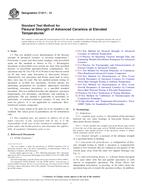 ASTM C1211-13
ASTM C1211-13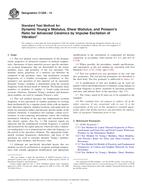 ASTM C1259-14
ASTM C1259-14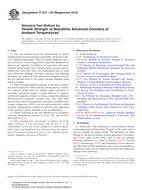 ASTM C1273-05(2010)..
ASTM C1273-05(2010)..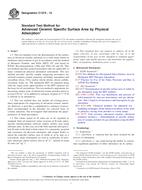 ASTM C1274-12
ASTM C1274-12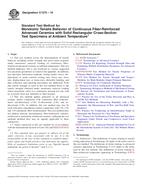 ASTM C1275-10
ASTM C1275-10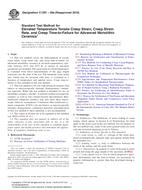 ASTM C1291-00a(2010)..
ASTM C1291-00a(2010)..
 Cookies
Cookies
